As at March 2023
Equity Market Returns
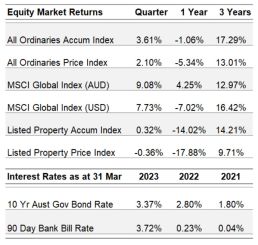
Source: Capital IQ, MSCI
Overview – Hugh MacNally
Despite the issues that arose in the global banking system at the beginning of March, equities markets rose over the quarter. The Australian market was up 3.6% and the global markets were up 9.1%, as measured by the MSCI (a global index of stocks) in A$.
Central banks continued to raise interest rates during the quarter, although, they indicated that the pace of rises would likely slow. Of significance, bond yields fell sharply from a high of over 4% in the US to below 3.5%. In Australia, the 10 year bond fell from a high of 3.9% to under 3.2%. The fall in bond yields were influenced by the change in stance of central banks and falls in inflation rates, although these remain well above target levels.
Our view is that the banking system problems are receding after decisive action by central banks to prevent any widening of the extent of the problem. The situation that arose was materially different to that of 15 years ago during the GFC. In the recent situation, the banks had strong capital positions and sound lending books, something that was the reverse of the catastrophe of the GFC. Silicon Valley Bank, which was not designated as one of the Systemically Important Banks and was the proximate cause, had a number of weaknesses, which escaped the stress testing regime; a case of Generals fighting the last war. Damage has been limited to a small number of banks, only one of which, Credit Suisse was a Systemically Significant Bank. Wider issues of the structure of bank balance sheets in the US will require change, as has been pointed to by a number of respected bank CEOs, and further regulation will likely follow.
There was little disruption in the Australian banking system as the Australian banks having different structures that make them less susceptible to the panics that occurred in the US and Switzerland.
The implications for the wider economy are not clear at this point, but it is important that the problems were not those of bank solvency, something that we saw in the aftermath of the GFC which took a long time to repair and had consequences that extended over a great number of years. We believe, in this case it is confidence in a return to stability, and primarily just in the US.
In other areas of the market the reactions were not negative. In the Tech sector share prices rose sharply. Stocks held in the portfolios, such as Nvidia, Microsoft, TSMC rose strongly from what had become quite low prices. As a whole, the Nasdaq Index (largely tech stocks) rose 17.7% during the quarter.
In defensive sectors, such as healthcare and non-discretionary consumer products, the reaction was muted. Companies such as Woolworths in the domestic portfolios and pharmaceutical company Merck & Co. and Nestle in the global portfolios produced positive results for the quarter. In other areas of healthcare results were mixed.
Interestingly, two sectors that might have been expected to show weakness as a result of economic concerns, such as, building materials and discretionary retailers were largely unchanged. Examples in the portfolios are JB HiFi and Harvey Norman. In the case of James Hardie the share price recovered strongly. The share prices of companies in these sectors have already declined substantially in the last year and in our view are attractively priced; a number have very high dividend yields.
The resources sector ended the quarter largely unchanged, after strong rises at the end of 2022. Manufacturing stocks both domestic and global, such as Amcor, Orora, Orica and VW had shown little direction over the last quarter. We view the valuations as being undemanding.
Overall, we think that the banking issues of March, while being headline worthy, have passed the critical point. Inflation seems to be slowing and some of causes, the supply constraints, in chips and commodities, are also resolving. Share prices in our view are attractive in quite a number of areas.
International Equities
Hugh MacNally
International Equities Performance
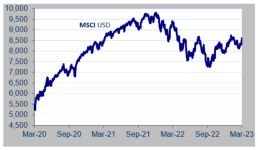
Source: MSCI
Global markets rose strongly during the quarter with the MSCI up 9.1% in A$ terms. Markets rose until the beginning of March, then retreated sharply as the US and Swiss banking issues unfolded but recovered towards the end of the month.
The effect on the bank stocks held in the portfolios was not that significant; Lloyds share price was little changed at the end of the quarter, however, Wells Fargo was down approximately 10% and down 20% on recent highs. We think that the fall in share price will be recovered in time.
The gyrations in many bank share prices were however extreme. The collapse of Credit Suisse (CS) and subsequent acquisition by its competitor UBS we think offered an opportunity to acquire stock in the latter at a knockdown price. UBS acquired CS for SFR3.2 Billion (plus certain guarantees from the Swiss National Bank). The purchase included CS’s wealth management business with approximately $650 Billion under management and what we estimate to be SFR40 Billion in net tangible assets. This put the purchases of UBS at a significant discount to its tangible asset backing. UBS return on capital is approximately 15% and this, we think, makes the purchase very attractive.
The technology sector continued the recovery that started late last year. The main holdings in the portfolios: Microsoft, Cisco Systems, Amazon, Nvidia and TSCM performed well in share price terms. Operationally the performances have however been mixed as the demand in the tech sector has been adversely affected by over-investment and the implosion of some of the wilder applications, such as crypto (which is big users of data centre capacity and high-end chips). However, we feel the prices of these stocks had fallen so far that they were attractively priced. We think that the underlying demand, particularly in high end chips, remains very strong and that growth will continue for an extended period of time. The rapid increase in valuations has tempered our enthusiasm for further purchases.
DR Horton (DHI), the largest house builder in the US (they build approximately 12% of single-family homes in the US), has long been helding in the portfolios. The company has achieved strong growth in revenue and market share over the last decade and is conservatively financed and well managed. Returns on capital are extremely attractive. While they have achieved strong growth, the environment has not been one of excessive construction, volumes have been well below long-term averages for the last decade, with substantial demand unfilled. The sharp rise in mortgage rates over the last year has however reduced demand and this was reflected in DHI’s recent result which was down 16% on previous corresponding quarter. Margins were also down on the very high levels achieved through 2022. Despite the lower profitability in the last result and the uncertainty over sales in the near term the stock price has risen from a low of under $60 to $95 in the last year. The current slowdown we think is a pause in the in a longer-term growth trend and the decline in DHI’s profit a reduction from a high level and one that is nevertheless very attractive.
In the health care sector, Quest Diagnostics has been held in portfolios since the middle of last year. The company had massive revenue growth during Covid, as a result of the windfall testing the company performed. A bottoming in revenue is expected to occur this year followed by a resumption of growth in the region of 5%p.a. and earnings growth of 8-10%.
The company is one of two dominant supplies of pathology testing services in the US; together the two account for in excess of 50% of testing. The company has grown organically and through bolt on acquisitions, on which it has spent an average of $300 million p.a. over the last 10 years. Improvements in testing efficiency and transport cost efficiencies have aided the growth in profitability and returns on capital. In the longer term it is thought that increased testing for diseases such as cancer will also aid revenue growth. The company is attractively priced, and the market has for some time regarded Covid-19 revenues as a one off event.
Australian Equities
Peter Reed
Australian Equities Performance
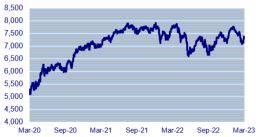
Source: Capital IQ
Following a strong start in January, the domestic market tracked the gyrations of international markets, before finishing the quarter 3.6% higher.
Aggregate company profits and dividends for the half year ended December were wer in-line with market expectations on slightly better than expected revenues.
A number of companies reliant on consumer spending indicated a more difficult operating environment as central banks in Australia and overseas tightened monetary conditions. Harvey Norman saw lower than expected sales, particularly in November/December and extending into the new year. There was always going to be a weakening from the previous year’s Covid-19 induced sales surge, but the pullback was exacerbated by a cool wet summer which saw a drop in outdoor furniture and air conditioner sales, along with a spike in inventory levels. We view HVN as a well-managed business and have confidence in their ability to deal quickly with any inventory overhang. The company has a track record of delivering attractive returns to equity holders and so the share price fall opens a buying opportunity, in our view.
James Hardie’s December quarter results also saw a tougher trading environment with North American sales volume down 10%. The volume decline was largely offset by price and product mix, but the results indicate a rapid deceleration in its end market as interest rate hikes cool demand (see comments on above on DR Horton, a major customer). Despite this the stock remains a core portfolio holding due to its dominant market position and outstanding return metrics, even in difficult market conditions.
Resource stocks continued their string of strong earnings. Our diversified mining exposure – BHP & Rio – benefitted from an iron ore price well in excess of USD100/ton. For Rio this contributed to underlying earnings of USD13.3 billion for full year 2022, which although down from its peak of 2021, was up 7% from 2020 levels.
BHP produced similarly strong returns, benefitting from its industry leading cost position for iron ore; return on capital employed for the half year to December ’22 was a robust 29.4%. The company maintains a strong balance sheet, which, despite higher future capex requirements, places it in a good position to maintain an attractive dividend pay out to shareholders.
Newcrest, a gold miner held in the portfolios, was noteworthy for the all-scrip bid it received from US gold producer Newmont. At this stage our position is to wait and see how the bidding progresses, noting that the first bid is usually not the last. Further, we suggest that the timing of the bid would likely be backed by a positive outlook for the gold price by Newmont management. If this is the case we would concur, with inflation rising to levels not experienced since the 1970s. Hedging against such an environment was the basis for including gold exposure in the portfolio and instability which has hit financial markets in recent weeks adds further weight to this position. We note that the gold price is now skirting with record high levels around USD1,986 per ounce.
CBA was the only one of the major banks to report during the quarter. Although it is not held generally across PPM portfolios – for valuation reasons – the stock is a good bellwether for the sector. As we have mentioned in recent banking commentary, the main focus of the market has been the trajectory of net interest margins (NIMs), the difference between what the bank pays depositors at what it lends those funds out for.
Until recent ructions in financial markets, we were of the view that bank NIMs would likely see further expansion, perhaps through to the second half of the year. This was, to a large extent, due to expectations of further RBA rate hikes, a conducive environment for NIMs as the banks rapidly pass on the higher costs to borrowers whilst slowly moving rates for depositors. However, with global financial markets coming under pressure and with a number of surprising and notable bank failures we can observe that global monetary conditions have tightened exogenous to central bank actions. This may partly obviate further rate hikes, with the implication that the outlook for NIMs for the Australian banks may peak earlier than expected.
At the same time, we note that the banks maintain strong capital levels with ample liquidity. The loan books are in sound condition and the sector is well regulated. Focus for us remains bank progress on improving their return on equity. We now see ANZ approaching 11% return on equity, whilst Westpac is slightly over 10%. Given both banks are priced at around book value, this indicates to us an acceptable return outlook for investors in these two stocks. CBA is simply too expensive; NAB, although not as expensive as CBA, will likely continue to be used as a funding source for other investments.
Interest Rates
Ian Hardy
90 Day Bank Bill (%) vs 10 Year Bond (%) Performance
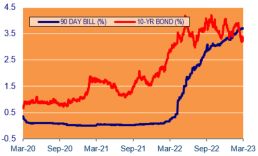
Source: Capital IQ
The first quarter of 2023 has once again seen central banks around the world raising interest rates in an effort to curb inflation.
At its March meeting the US Federal Reserve increased the federal funds target range by 25bp to 4.75-5.00% and indicated that some further policy firming may be appropriate, in order to return inflation to 2 percent over time. In addition, the Committee will continue reducing its holdings of Treasury and other securities. The recent banking problems arose subsequent to the Federal Reserve’s decision and may see further monetary tightening put on hold until these issues are resolved and stability returns to the banking system generally.
Interestingly, this did not stop the Bank of England from raising rates at its March meeting by .25% to 4.25%, although the committee noted, “there have been large and volatile moves in global financial markets, in particular since the failure of Silicon Valley Bank and in the run-up to UBS’s purchase of Credit Suisse.”
In Australia the Reserve Bank (RBA) held the cash rate at 3.60% at its April meeting, after ten consecutive rate rises. The Board noted that monetary policy operates with a lag and that the full effect of the increase in rates is yet to be felt. It thus “took the decision to hold rates steady this month to provide additional time to assess the impact of the increase in interest rates to date and the economic outlook.”
“The Board expects that some further tightening of monetary policy may well be needed to ensure that inflation returns to target.”
Unlike the RBA, the RBNZ raised the Official Cash Rate by 50bp to 5.25% a day after the RBA paused.
The Australian commercial rate curve is slightly inverse, with 30 day bank bills 3.64%, 180 days 3.77% and 1 year swap 3.56% and 3 years 3.32% at the time of writing.
Property (REITS)
Franklin Djohan
ASX Property Graph
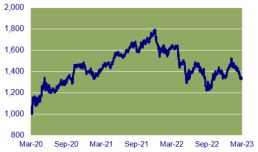
Source: Capital IQ
After the ASX property Index rose 13% early in the quarter it gave back most of the gains to end up only 0.3%.
After the very substantial decline in price over the last year it had seemed that the market offered reasonable value, particularly after the sharp decline in bond yields over the last month (listed property has often been regarded as a bond proxy and should thus move in response to changes in bond yields).
HMC Capital (HMC), which is held in the portfolios, announced a capital raising of $155 million to participate in the acquisition of 11 Healthscope hospitals. Other related entities, HealthCo Healthcare & Wellness REIT (HCW) and a newly established unlisted healthcare fund will participate acquisition and raise capital separately. The acquisition totals $1.2 billion and will be funded from the raisings and existing debt facilities. After the decline in share price over the last 18 months, from in excess of $8 to under $3.70 the raising appears good value.
We are looking among the listed trusts for opportunities where valuations have declined excessively. The concerns regarding future occupancy levels have been around for some time and we are looking for opportunities where this has been already reflected in the price.
PPM is continuously looking for ways to improve the service we provide to you and your feedback is important to us. We hope are staying safe and healthy. Please contact Jill May, Head of Client Relationships with any questions, comments or suggested improvements at jm@ppmfunds.com or on (02) 8256 3712.
Private Portfolio Managers Pty Limited ACN 069 865 827, AFSL 241058 (PPM). The information provided in this document is intended for general use only and is taken from sources which are believed to be accurate. PPM accepts no liability of any kind to any person who relies on the information contained in this document. The information presented, and products and services described in this document do not take into account any individuals objectives, financial situation or needs. The information provided does not constitute investment advice. You should assess whether the information is appropriate for you and consider talking to a financial adviser before making any investment decision. Past performance is not necessarily indicative of future returns. © Copyright Private Portfolio Managers Pty Limited ABN 50 069 865 827, AFS Licence No. 241058.
Your Investment Management Team

Hugh MacNally
Portfolio Manager,
Executive Chairman

Peter Reed
Portfolio Manager,
Director

Franklin Djohan
Portfolio Manager / Analyst

Max Herron-Vellacott
Portfolio Manager

Neil Sahai
Portfolio Manager